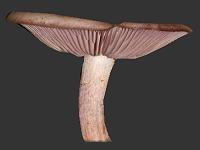Roscadghill Parc Wildlife - Fungi
(42 species currently featured)

Brain, Tripe and Jelly Tooth Fungi
Ascomycota are a hugely diverse group of fungi. They have fruiting bodies can form cups, discs and saddles although some may only be seen as a powder-like substance, as with Powdery Mildews.
Cups, Jellydics, Eyelashes and Saddles and other Ascomycota
Oomycota are another fungal group and include Water Moulds, Downy Mildews and Egg Fungi.
Lichens are commonly found on the sides of buildings, on un-washed cars, encrusting stones in walls, or adorning twigs, branches and trunks of trees, they are not true fungi but are a mixture of both algae and fungi living together symbiotically for mutual benefit.
Slime Moulds are included here only because they resemble fungi but are completely unrelated to them; they are often found under rotting timber or on lawns, moss and leaf litter.
Slime Moulds (Myxomycetes and Ceratiomyxomycetes)
A greater selection of images of fungi can be found at APHOTOFUNGI. A web-based educational photographic resource dedicated to the identification of fungi found across South-west England by David Fenwick.